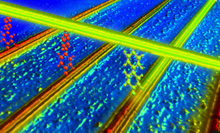Scientists at HP (and you thought Fiorina had fired ’em all) have done something interesting. (Picture of HP crossbars from Worldchanging.Com.)
The biggest problem in chip design today is the heat generated by electrons going from place to place. That’s why Intel has switched entirely to low-power designs. That’s why multi-core is so hot.
So HP scientists simply embedded a grid between layers in a silicon chip design. Instead of moving along wires, on a two-dimensional grid, electrons bounce through a three-dimensional array. The grid needs no wires, there are literally 8 different ways any electron could bounce, so everyone can squeeze closer together.
This is actually pretty cool. It leads to headlines like this one — Can HP Fool Moore’s Law? To which Mr. Moore would, I’m sure, reply as he’s responded to every other attempt (including mine) to expand the reach of his original 1964 article — his law only applies to 1964 technology.
Be that as it may, it’s still cool. Wires? We don’t need no steenkin’ wires!
It also reflects what I’ve said about Moore’s Law since I started
covering it, six years ago now. It’s not just exponential, but
compounded. Breakthroughs happen in multiple directions, all driving
exponential change, which leads to more breakthroughs driving
exponential change. Faster and faster gets faster and faster.
In the case of HP, this is another application of what it calls crossbar technology. Previously, HP claimed the designs could reduce manufacturing defects and even replace computing components. While HP works with crossbars, other companies are working on other technologies and, in time, these innovations may be combined, compounding their impact further.
Chip designs can now break into the third dimension. But the process of innovation has already hit the fourth.










